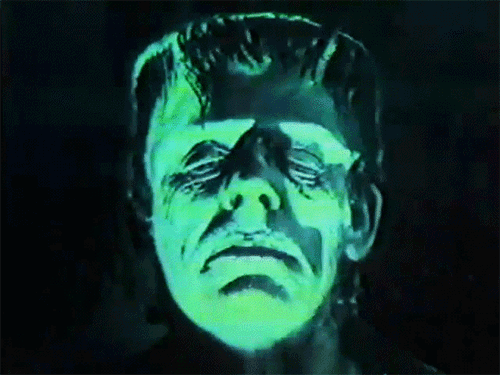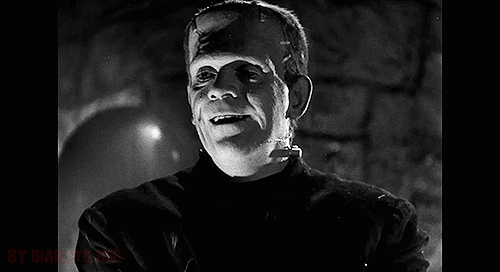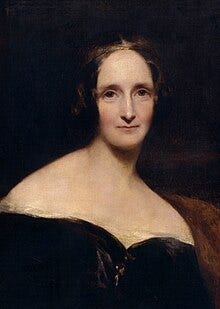Hello, fellow ghost reader!
Welcome back to my Substack!
This week I’m talking about Frankenstein, Mary Shelley’s most famous work.
I wasn’t intending to write anything on this book maybe ever. I’ve mentioned before that during my days in academia my research was primarily based in Romantic Gothic literature, and I have written about Shelley before. But I was never really that bothered by Frankenstein, or the other famous works in the canon of ‘female Gothic terror’. My thing was always more ‘male Gothic horror’, and Frankenstein in particular is a work already saturated with far better criticism than I could ever hope to produce. Moreover, it’s Halloween time and my Substack feed is unaccountably crammed with pieces on Frankenstein already, so I figured I’d rather write about other spooky books to keep it all balanced.
That was until I recently came across a post on this iconic text whose intention was to make a case against the argument that ‘Victor is actually the real monster’. Interesting, I thought, as someone who generally feels that, while Shelley’s work is more complex than presenting a simple hero/villain dichotomy, if I had to choose who was most villainous, it probably would be Victor. I read this post and, although I didn’t disagree with everything it said, fundamentally my mind wasn’t changed.
Now that alone would not be enough to get me to write this post - everyone is entitled to their opinion after all, and the intention of this little piece is not to ‘disprove’ their point. But what really got my attention was that this piece opened with the insinuation that the argument that Victor is the real monster of the text is nothing more than intellectual posturing, and that anyone making the argument clearly could not have actually read the book. (All while referring to the creature exclusively as ‘the monster’ which is not textually accurate, I might add).
As someone with an endless appreciation for literary discourse, this attitude to any text, or interpretations thereof, just doesn’t sit right with me. All art is subjective and every text is worth the attention of any and all individual gaze precisely for this reason. This is why we have built up a whole discipline of the study of literature (and one that is sorely under threat in the current climate let’s not forget). What would be the point of any of it - in reading at all - if the answers are ‘obvious’ and we’re all just supposed to come to the same conclusion? Especially when those conclusions might express views and opinions which you, yourself, might not have considered before.
There is so much academic criticism supporting the reading of a monstrous Victor, an un-monstrous Victor, and text in which there are no monsters at all! - people’s work and research based on valid historical, textual and para-textual evidence that deserves to be heard, and which still fails to find consensus even within that a singular umbrella argument. The many ways of interpreting this text - feminist, post-colonialist, marxist, queer, Miltonic, philosophical, theological (and so many more I don’t even understand) - is exactly what defines its genius, each reading shifting our perspective on the moral landscape of the text in tiny, ground-breaking ways.
We do a disservice to these people by implying that there is anything ‘obvious’ about the text, and to Shelley herself, who, trust me, was far too smart to write anything as simple
I just want to be really clear again that the purpose of this piece is not to get back at one individual writer, but to celebrate different ideas and encourage even more discourse around this iconic text.
Therefore, I present my two cents on what I personally think Shelley is trying to say about monstrosity. There is so much more to be said about all the philosophies of this ingenious work than my little piece can cover. I’ve tried to keep this one argument concise enough to inspire your imaginations as to how it might be built upon, or even contradicted. I encourage you to seek them out, and disagree.
So, without further ado, just one interpretation of Frankenstein, in which I discuss where Shelley thought monstrosity really lies, while also defending the opinion that Victor is a little creep. Enjoy!
A ghost reader 👻
To clarify, I don’t think that the creature is ‘the good guy’, or even ‘A good guy’, but my real thing is that (aside from the fact that I do think the creature has some redeeming qualities, unlike Victor) I don’t think that Shelley’s intention for the novel is to stage Victor and the creature in opposition to one another, nor can the ethical questions raised in the novel be purely confined to these two men or their troubled father/son dynamic.
As anyone who’s read the novel will know, this is a narrative that is intensely confined to the lonely inner worlds of these men. It’s an incredibly claustrophobic, bleak read (part of the reason I sometimes struggle with it), as we’re shackled inside the recorded minds of not one, not two, but three men (the third being Robert Walton who’s role it is to record the tale), all intent on leaving civilisation behind and heading into the barren wastes with nothing but their own thoughts for company.
There are very few female characters, most of whom die, and none of whom really break past the male dominated narrative action. Their absence is conspicuous, considered fleetingly by their male counterparts who never allow them into the novel’s heart, so consumed are they by their respective masculine pursuits.
Because of this, it becomes tempting to pit them against each other, but how can this be Shelley’s intention for the reader when the only characters this might benefit are three objectively terrible men? Of course, it’s fun to give into this impulse - I’m about to do just that myself if you couldn’t tell - but doing so exposes its inherent futility, and thus the futility of these character’s journeys. The question Shelley is asking is not ‘which individual character is the ‘real’ monster?’, but rather ‘where in the text does monstrosity lie?’ So let’s investigate this, starting with the men in question.
Victor represents a kind of enlightened masculinity - not only does he pursue scientific advancement, but he suggests it has been borne out of philosophy (an early example of (bad) scientific ethics) - pioneering new technology as a means of circumventing the base human instinct towards sex. (Charlotte Gordon, in her work, suggests that this is subtly reminiscent of Mary’s father - the Enlightenment philosopher, William Godwin). Robert Walton represents a colonial masculinity - spearing our into the unknown at the wrong time of year (according to some meteorologists who have taken an interest in the text) effectively for the purposes of planting a flag. (I’m not going to spend much time on Robert here, but suffice to say he is a very unreliable narrator). The creature takes on a classical, pre-Christian masculinity, emphasised through his olympian stature, as well as the evident orientalist representation of his physical appearance:
His limbs were in proportion, and I had selected his features as beautiful. Beautiful! Great God! His yellow skin scarcely covered the work of muscles and arteries beneath; his hair was of a lustrous black, and flowing; his teeth of a pearly whiteness; but these luxuriances only formed a more horrid contrast with his watery eyes, that seemed almost of the same colour as the dun-white sockets in which they were set, his shrivelled complexion and straight black lips.
(ch. 5)
If we can even think of him as a man, he is certainly a marginalised one.
These are the gods of this story. By which I mean they are all men who would make themselves gods in some way, hence their mutual impulse to strike out into the bleak, lifeless landscapes, which stage the novel, and which broadly represent a world without reproduction.
This lends Frankenstein an obviously queer context, of course, not to mention the obvious racial and theological commentary one could draw from these initial musings. The homo-sociality is palpable, if not outright erotic. And this - the not-so-subtle rejection of female company - I believe is the crux of what Shelley intended the novel’s morality to address. I think Shelley’s intention is to the danger of men wanting to conquer every part of the world - through means scientific, violent, or exploratory - and the destruction wrought by the conflict, or even just dialogue, between them when women aren’t involved.
Obviously none of the men have much to recommend them, but I think the creature is exceptional. For one thing, he expresses himself not just eloquently but truthfully express himself. He doesn’t lie or manipulate his own narrative as Victor and Robert do. Where they use their Enlightenment education to exploit meaning, the creature instead takes on the quality of Renaissance Humanitarianism, learned through reading Paradise Lost, and which idolises language as a means of accessing truthful self-awareness. (For the record, this is not to say that the creature is a reliable narrator either - the fact that his chosen text is Paradise Lost is enough to explain it alone - just that, broadly speaking, he is more interested in telling his story through feelings rather than reason). But the really important aspect which sets him apart is that he the only one who identifies and understands that the female could in some way be valuable, even desirable, and intrinsically linked to life. ‘You must create a female for me with whom I can live in the interchange of those sympathies necessary for my being’, he says to Victor. When Victor eventually refuses to bring the female creature he builds to life, the creature doesn’t target him, but his fiancé, Elizabeth, understanding that this is the most damaging attack.
Victor’s refusal speaks to his own dark perversions - that he cannot conceive of a living female body. Not only does he aim to create life without female intervention, but having agreed to create the female creature and having spent months on her creation, he looks upon her lifeless female form and cannot help but imagine her sexual desires, ultimately deciding to keep her dead:
I was now about to form another being of whose dispositions I was alike ignorant; she might become ten thousand times more malignant than her mate […] the creature who already lived loathed his own deformity, and might he not conceive a greater abhorrence for it when it came before his eyes in the female form? She also might turn with disgust from him to the superior beauty of man; she might quit him, and he be again alone, exasperated by the fresh provocation of being deserted by one of his own species.
Even if they were to leave Europe and inhabit the deserts of the new world, yet one of the first results of those sympathies for which the dæmon thirsted would be children, and a race of devils would be propagated upon the earth who might make the very existence of the species of man a condition precarious and full of terror.
(ch. 20)
There is a clearly sexualised desire to his gaze upon the dead female body which is even directed towards his own fiancé. For most of the book, Victor only discusses Elizabeth in sexless, friendly, even sisterly terms. It is only when she is killed that he is able to passionately embrace her dead body in an obvious expression of sexual desire:
as she lay, her head upon her arm and a handkerchief thrown across her face and neck, I might have supposed her asleep. I rushed towards her and embraced her with ardour, but the deadly languor and coldness of the limbs told me that what I now held in my arms had ceased to be the Elizabeth whom I had loved and cherished. The murderous mark of the fiend’s grasp was on her neck, and the breath had ceased to issue from her lips.
(ch. 23)
**Note how her face is covered, reminiscent a theme I explored in my last post(s) on literary decapitation (linked below if you’re curious). I think it’s an interesting study question to consider how this form of literary headlessness mimics/contrasts with the construction of the female creature’s body Victor undertakes - comment with your thoughts!**
I personally don’t think Shelly conceived of her novel within a binary mode of morality. Instead the narrative explores the creature as a product of a ‘childhood’ without a mother as was the state of her own childhood (and by ‘mother’ I do mean Victor, but I’m not going to get into the genderqueer underpinnings right now). He may commit horrific acts, but he is the consequence of Frankenstein’s own reprehensible actions.
Perhaps it’s possible to raise Victor’s tender age (only twenty when he creates the creature) as some kind of mitigating factor, and see the whole narrative as a ‘worst case scenario’ take on the mistakes we make in our twenties. It’s certainly interesting to think about the fact that Shelley herself was twenty when the book was published having written this book in exile for eloping with a married man, with whom she had already had, and lost, one child, and in the wake of the rejection she faced from her own father, who had hitherto encouraged the casting off of societal convention, only to turn his back on her when she came to embody the freedom he previously extolled. ‘Am I not shunned and hated by all mankind?’ The creature pleads with Victor. ‘You, my creator, would tear me to pieces and triumph; remember that’ (ch. 17). Twenty-year-olds make mistakes and Mary was living with hers.
Obviously I’m not blaming her for the choices she made while chasing her happiness, but I think it speaks to the idea that Shelley was thinking about the difference between male/female accountability and responsibility. Having ‘birthed’ the creature, Frankenstein feels able to abandon his project and ignore any responsibility he might owe. He doesn’t get away with it, of course, but, it’s not hard to imagine how this would have played out in a less fantastical, real-life scenario.
The creature is the real monster only so far as he represents patriarchal masculinity as being something man-made and unnatural, but Shelley never lets us see this image as one separate from its creator.
Ultimately, only one blanket statement can be made about about the many forms monstrosity takes on in the novel, and that is that they are all male. By confining us to the minds these three men, Shelley at once invites us into the mind of ‘God’ (by which I mean, those who would be gods), then lets us see how small it really is. Shelley’s novel holds a scathing light up to patriarchal sovereignty, rejecting the institutions by which men have come to dominate by making them literally monstrous, all the while asking
tell me why I should pity man more than he pities me?
(ch. 17)
Ghost Reader Substack, ‘Losing Your Head’ Part I:








Thanks for following my smol Substack. Anyone who writes about Shelley and Frankenstein is worth a follow back in my book. Uh, pun intended. And Victor is definitely the bad guy.
oh i absolutely adored reading this and so glad i came across it! it was great to hear your interpretation! i'm not sure who (if anyone) i would paint as the monster in my own interpretation. i've not read it in years, but in regards to the monster, i think humanity itself arguably could be the true monstrosity of the novel.
slight bit of a tangent but one thing i'll always find interesting regarding this text (and i had to go back to old university notes to confirm) was the change in tone from the 1818 to the 1831 version, shelley almost becoming less progressive with that time - i'd noted in particular that during chapter 2 elizabeth was studying with clerval and victor, being part of that learning process in the 1818 version but then in the 1831 she was almost there just to encourage ("her smile, her soft voice, the sweet glance of her celestial eyes, were ever there to bless and animate us"). it's a small detail but something i find quite interesting. i wonder if this has any impact on how we view her death as a reader?
anyway, great read! (and forgive my spouting of this fact here!) i look forward to reading more from you :)